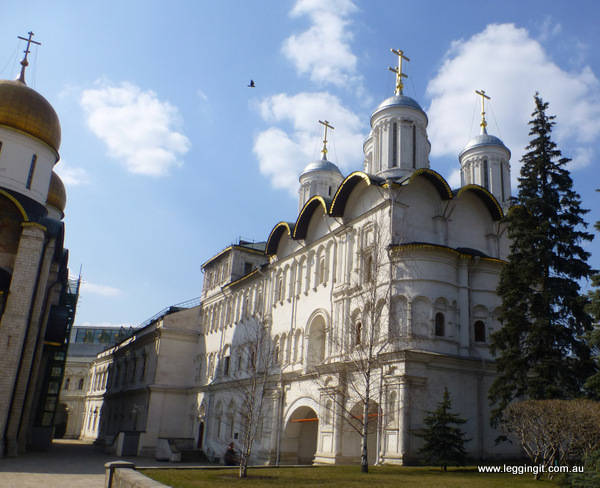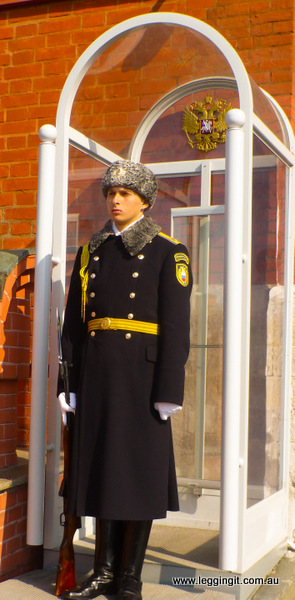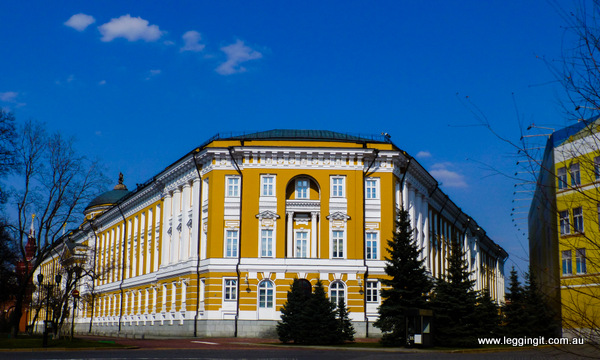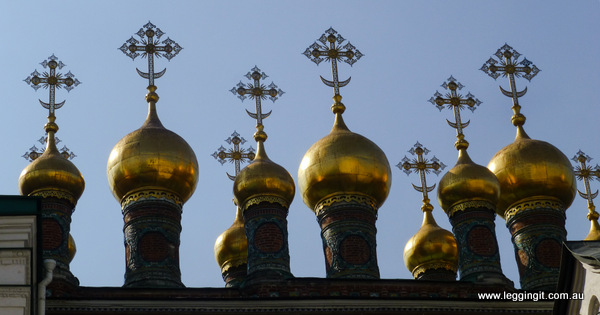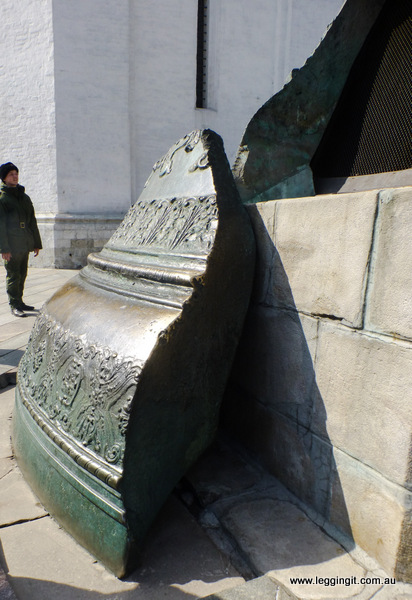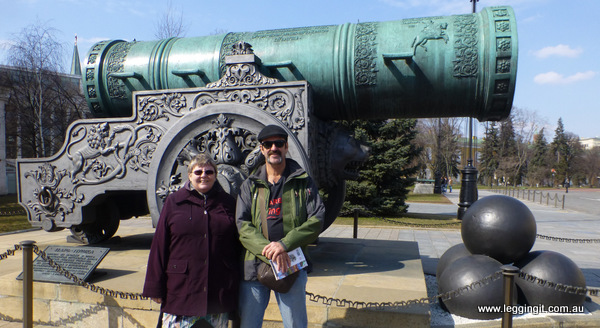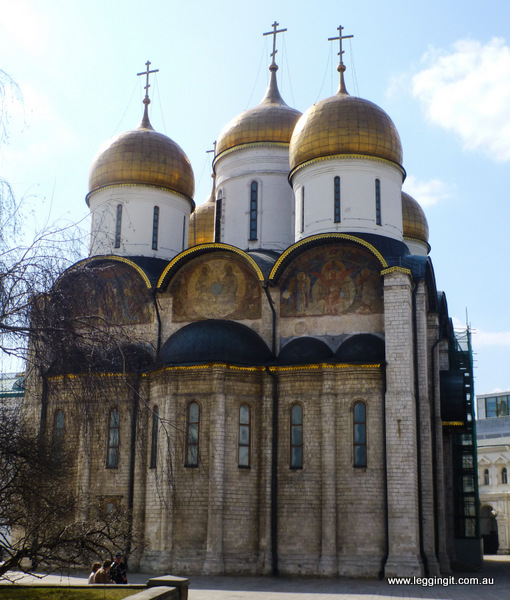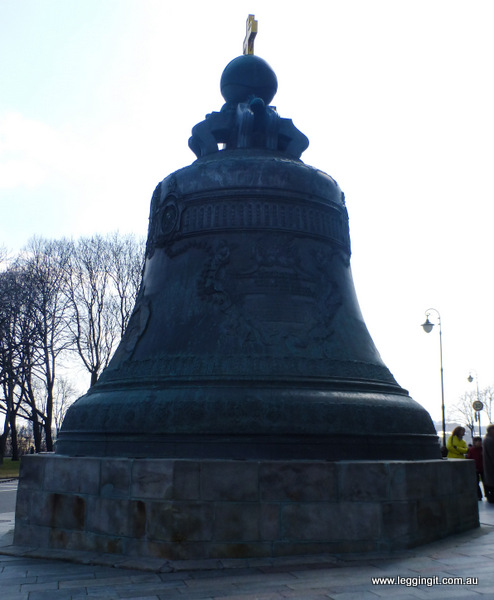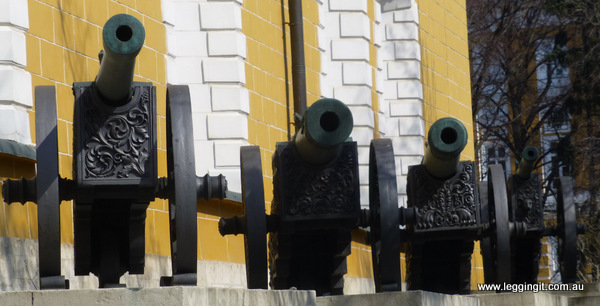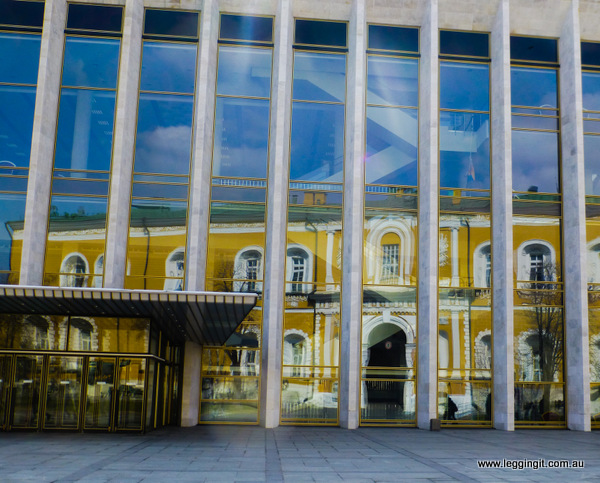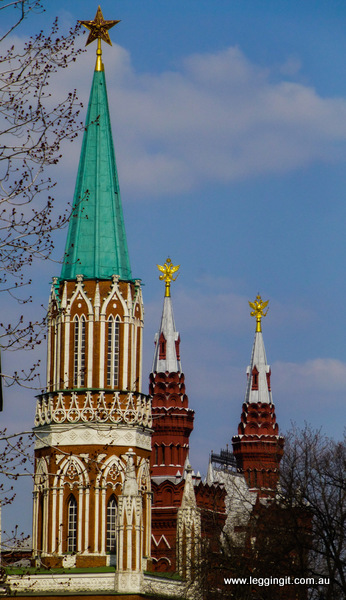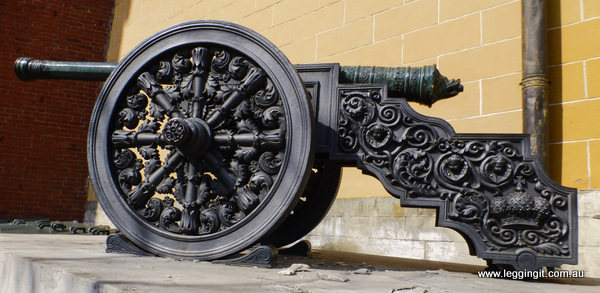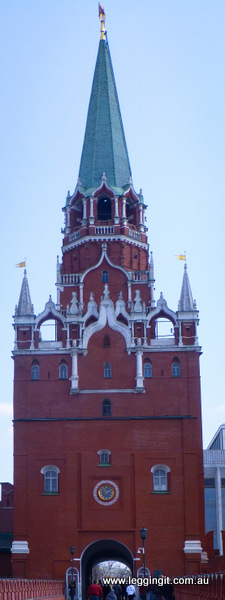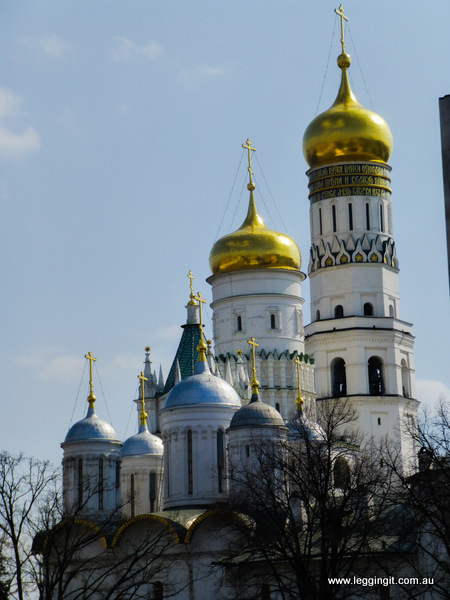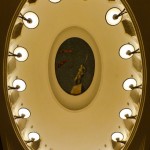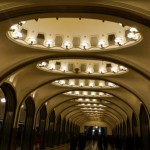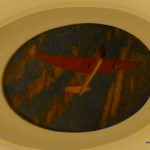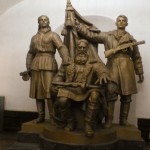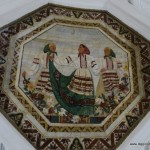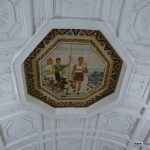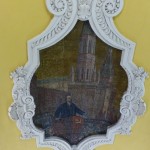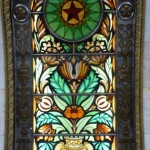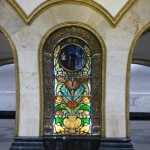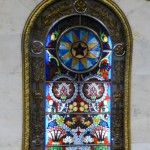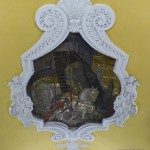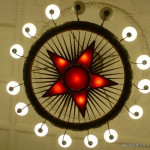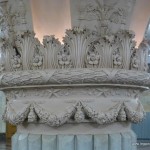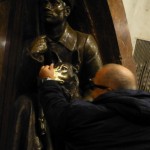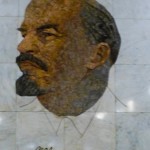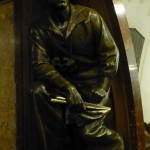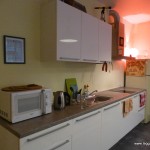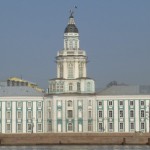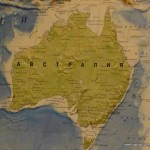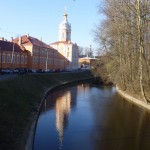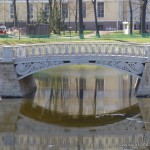Today’s plan to do a tour of the Kremlin and the Moscow Metro. That said it was a late start today we had plans of doing all sorts of stuff but instead just vegged out on Facebook. While we were having lunch, at an apartment store in the city, the strangest thing happened. A bloke sitting at the end of the cafe passed over a card in exchange for a wad of cash from a group of Asians. It wouldn’t have been so bad if it wasn’t so clandestine. Whatever it was he was trying to hide it. After our encounter with smugglers nothing surprises us. A little shocked we headed towards the Kremlin to meet up with our guide for the walking tour of the kremlin.
We headed out the wrong exit and ended up in Red Square. It was filled with heaps of people out enjoying the sunny day. We tried to work out where we were supposed to meet but for some reason the convert Russian to English cell in my brain wasn’t working very well and I couldn’t workout which street signs were where. I tried to ask directions but if you can’t pronounce a word in perfect Russian most people will just throw up their hands “I don’t understand”.
We were panicking we’d missed the tour and the station was on the other side of the Kremlin (we didn’t realise the bridge we passed under was the tourist entry). Eventually we stopped and took stock of the situation. We checked the landmarks and found out where we were and asked a policeman where the station was. (Always ask policeman they have to give directions, it’s part of the contract, serve and protect …..or is that just in the movies?
We couldn’t find Pavel our guide so we joined the ticket line. I swear Russians love lining up as much as they love vodka (it takes them back to the good old days of bread and food shortages). There was no sense of order long lines snaked around the undercover area spewing out onto the park. Organised chaos……. It’s one of Moscow’s biggest tourist attractions but have they got large signs above the ticket windows showing prices so that by the time you reach the window you’ve decided what you’ll get. Hmmmm No…..
Foreign tourists visit the kremlin but have they got a sign at the ticket window in a universal language like say English hmmmmm no…… People line up but do they use barriers like at airports to funnel people through in an orderly fashion. Hmmmm no….. So the lines are all over the place, people can’t read the signs because they’re on A4 paper above the window. The whole time there’s people pushing in to read the signs and while they’re there they have to ask the ticket seller the prices and then they decide “well while I’m here I might just jack the line”
We bought tickets to all areas at 500 roubles but when we checked actually it was just to the exhibitions inside the Kremlin. Armoury tickets go on sale 40 minutes before opening times only and they’re an extra 700 roubles. It was a pity as we thought we could access the Armoury which we really wanted to do as it has an exquisite collection of faberge eggs, jewellery, golden objects, treasure. In itself it is reason enough to visit Moscow.
As we walked to the entry gate we finally found Pavel. He was a nice young local bloke who really spoke English well. As we entered the Kremlin and crossed the bridge it was changing of the guard. Soldiers in long dark blue greatcoats and fur hats slowly goose stepped, balancing rifles with chromed bayonets on the palm of their hands. The bayonets gleaming in the sun. It was a sight to behold. For an old drill instructor it was just beautiful. Entering the Kremlin we spotted an array of old brass cannons of all sizes from different countries. There were even some with decorative brass lacework on their gun carriages, wheels and cannons. Another thing of beauty to bring a tear to the eye of an old gunner.
The site of the Kremlin is where two rivers intersect, these day only one the Moskva is still visible as the Neginnaya has been covered over and only the outlet into the Moskva is still visible. The Kremlin area has been inhabited since 2nd century BC as it was on a trade route. It was originally forested but the trees were cut down to build wooden fortifications which were burnt down by a number of different invaders including the Mongols in 1237. It was sort of like the three little pigs but instead of huffing and puffing the Mongols just lit a match. It’s weird to think that the Mongols ruled Russia, but they did.
The walls were rebuilt in oak (you’d have thought they would’ve learnt after the place was burnt down) before being replaced in 1366 by a wall made of limestone and covered in white clay, the colour of which Russians believed to be holy. The walls have since been rebuilt in red brick but at the bottom of the kremlin wall the original white plastered walls can still be seen. The wall is about 2 km’s long and ranges from 5 to 19 metres in height according to the terrain. The walls thickness is from 3.5 metres and around Mr Putins bedroom about 6.5 metres, so he can sleep soundly. These days he lives out in the suburbs and has had a helipad installed so that he can pop in and out and avoid the Moscow traffic congestion.
A story goes that in the past government officials had blue flashing lights on their vehicles “Blue Buckets” and would use them to cut through traffic. However soon celebrities and businessmen had flashing blue lights as they’d simply bribed officials. A number of accidents, some fatal, between “Blue Bucket” cars and other citizens sparked protests after official cars were almost never found to be at fault. Then in February 2010 an accident between the Deputy Director of an oil company with a blue flashing light, where two physicians in the other car were killed sparked a major protest which took place in April.
The Blue Bucket Society took their protest to the streets attaching blue children’s sand buckets to the roofs of their cars and forming a motorcade. A few arrests were made but this only strengthened the support of the protest by the population. Soon they had local and national coverage as the protest was beamed across by television stations. The Blue Bucket Society has since funded the victims’ cases against crashes with VIP’s “Blue Buckets”. Some of the famous cases have discovered that the “Blue Buckets” were being used by security staff as taxis, or that drivers have been driving on the wrong side of the road eventually the blue light were banned.
We continued our walk past the State Kremlin palace a big monstrosity of concrete and glass, built in 1961 which was originally built for Communist Party Congresses but these days it hosts cultural events including quite recently Metallica.lol
The presidential palace area of course was off limits protected by guards and the inner sanctum by specially selected soldiers 50/50 conscripts and regular army. These soldiers are selected for their height (must be over 186 cms tall) and must be of Slavic appearance. One of the buildings was being renovated so was covered in a huge drop sheet with the building painted on it. It look a little while to work out whether it was real or not.lol
The Tsar cannon was quite interesting with massive cannons balls which supposedly can’t fit inside the barrel, and a brass lions head underneath with an expression like ” can someone get this thing off my back”
The Tsar Bell was near the cannon. It’s the largest in the world weighing in at a whopping 200 tonnes. The original bell fell from the bell tower after a fire in 1701 and from the pieces the new bell was made but bigger by Tsarina Anna. It was still in the casting pit when the Kremlin caught fire in 1737 and in an attempt to put out the fire, cold water was poured over the red hot bell. This caused the bell to crack and an 11.5 tonne chunk to break off. The chunk alone is as big as a person.
The Ivan the Great Bell Tower is right next to it. Until the revolution it was forbidden for any building to be built any taller than this and there’s a story that another building out in the suburbs was built a little taller but was struck by lightning and a subsequent fire which the Russians who are quite superstitious said was an act of god. The place was rebuilt but the next time a little shorter.
When Napoleon invaded Moscow and occupied the Kremlin one of his soldiers climbed to the top of the tower to remove the gold cross but try as he may he was not able to. Napoleon sent for a peasant who was sent up onto the domed roof and removed the cross. The Russians say that the crosses can only be removed by Russian hands. It dunno if that’s true but if it was me sitting on top of those domed roofs I’d be saying “sorry Bonaparte me old china plate, can’t seem to get it off must be hexed or something, you’ll have to send a peasant up”lol
These days there’s only a few of the original churches and cathedrals left in the grounds. The first churches were built around the 1330’s out of limestone much like the ones that are still standing. We went inside the cathedral and the interior was covered from top to bottom in murals. The layout was explained to us that on the front wall are all the apostles, patriarchs and of course Jesus. The icons, the four pillars which hold up the roof have pictures of the saints, as Russian Christianity isn’t too old they also borrowed a few saints from other countries. The back wall is dedicated to the apocalypse with St Peter leading the righteous, scenes with snakes and fire just to remind people as they walk out the door what fate awaits them if they stray off the path. The first cathedral was a crypt for various Tsars, Tsarinas and other nobility and it was quite crowded with monuments (almost like coffins).
As we entered the next cathedral a group of young soldiers were coming out and as they departed they stopped to bow and cross themselves. It was quite interesting that in the west religion is being turned away from in droves but here in Russia where religion was repressed for so long and many met their deaths for standing up for a belief that it seems that it is still strong. Stalin and successive presidents had tried to turn the country into an atheist state but despite all they’d done for whatever reason the people had maintained the faith. I suppose it goes to show the state can’t tell you what to believe in that’s a choice you have to make yourself.
The next cathedral was quite spectacular inside. All the Tsars had been crowned there, even Napoleon had himself crowned within the cathedral before he was forced to gallop back to France. These days it houses a collection of icons which were paintings of saints. To preserve them and stop wear and tear from daily rituals, silver covers were made with only the faces remaining visible in many. The paintings and icons were awesome, one in particular of St George was unlike all others with flesh colourings that are almost realistic. Pavel explained bit and pieces of orthodox religion to us and it really dawned on us that to visit places audio guides are great and guide books helpful but having a local there to ask, explain and flesh out questions certainly makes a huge difference. We’re not great fans of organised bus tours as we like to travel at our own pace and on bigger tours it’s hard to ask all the questions you want answered so the smaller walking tours are well worth the price to us.
The final church was small, almost a chapel which housed some more icons and bits and pieces. In days gone by the churches were used by the Tsars and their family. Ivan the Terrible built many churches maybe as a way of retribution for all the people he murdered and tortured. In the Cathedral the most holy place is said to be the right front area where the icons are so as an each way bet Ivan had himself buried there behind the screen. In the courtyard between the cathedrals we had views of Terrine Palace which supposedly is almost exclusive these days with tours costing $2,000. As time was getting away from us we had to skip a tour and headed back out the Kremlin gates for our next appointment, a Subway tour.
We followed Pavel back out and met up with a Swiss family with a twenty year old and an American guy who’d been stationed in East Germany when the Berlin Wall came down. It was interesting for when Pavel spoke the Swiss father translated into French. The subway boasts such things as the second most used after Seoul, moving on average 9 million people every working day, with a train every 90 seconds while we were waiting at one station it was 50 seconds from train leaving until doors opened on the next train.
The Moscow subway is quite famous for its elegance and beauty. When it was first constructed they simply dug the earth out, laid the tracks, formed the tunnels and back filled it with earth. British engineers were brought in as they didn’t have the expertise and when they were finished supposedly Stalin wouldn’t let them leave as he was worried they’d pass on all the plans of the tunnels to “the enemy”. The construction started in the 1930’s and it seems that the subway was a showpiece for the world, with stations with grand domed ceilings, they were lined with marble and all sorts of fine stone with each station designed with different themes so no two stations look the same. We visited a few stations Novoslobodskaya with beautiful stained glass panels, Komsomolskaya with designs like some of the palaces of France. Baroque style ceilings decorated with mosaic panels of stones. Mayakovskaya had ceiling mosaics of sky scenes. They were designed by a russian artist who wanted to represent the Russian skies. There’s all sorts of planes, balloons and scenes. Myakovskaya station became an air raid shelter during World War 2. Pavel showed us pictures of the platform covered in beds of locals and one of Stalin addressing local people and party officials on the platform in the station. It was packed.
Dinamo with its brown, white and yellow stone with lights behind gives the impression of electricity.
It was weird catching the escalator at the deeper subways. They were so steep and took up to two minutes to get from the bottom to the top. Ploshchad Revolyutsii, there’s 76 bronze sculptures one in each corner of the columns. There’s all sorts of sculptures from families, athletes, students, farmers, workers, hunters and soldiers. There is a frontier guard crouching with a dog whose nose people rub for good luck as they get off the train his nose bright and shiny. When we were told of this we thought it was a bit of hoax but sure enough when the train stopped, people got off they walked past giving the pooches nose a quick rub before continuing on their way. The statues have taken on all sorts of magical qualities and people rub the feet of some to improve their health. The strangest one was the babies penis was shiny, maybe expectant mothers or hopeful fathers wishing for sons, either way it’s still a little creepy.
After Stalin’s fall from grace all traces of him were removed from the stations. Strangely enough his face was absolutely everywhere watching over his flock so the task was enormous. Whole mosaics were redone with his face being removed from all sorts of godlike scenes. Statues of Stalin which were mounted on podiums in the station entries were removed. Without the statues some of the shrines looked a bit unfinished. In some areas Lenin, Marx or other people replaced Stalin in mosaics. Pavel showed us some of the old pictures of the stations prior to the removal and it must’ve been outstanding. Overall we only visited a small number of stations of the 194 stations
It was a great tour and we ended the tour with a great appreciation of the Moscow subway.
Tomorrow back to the embassy and hopefully visas.
